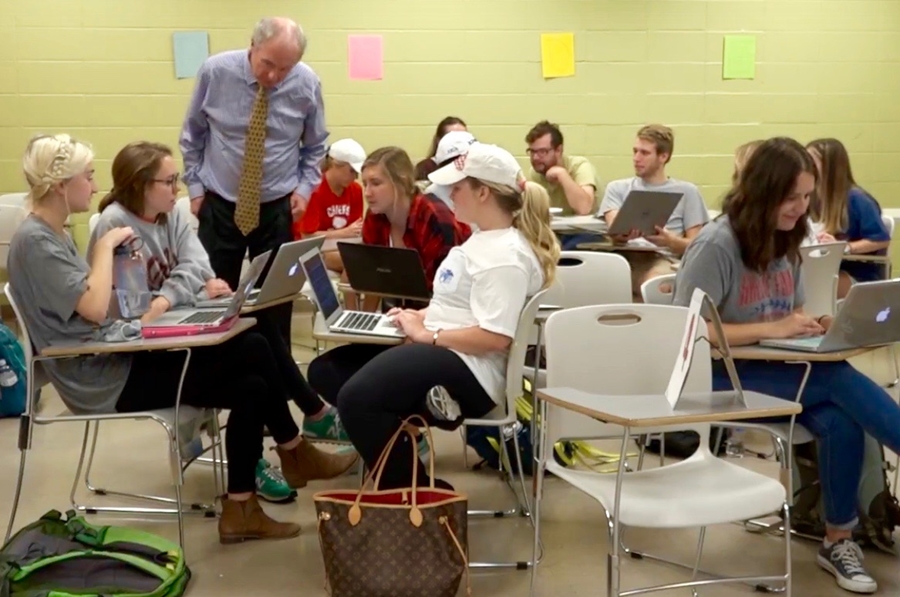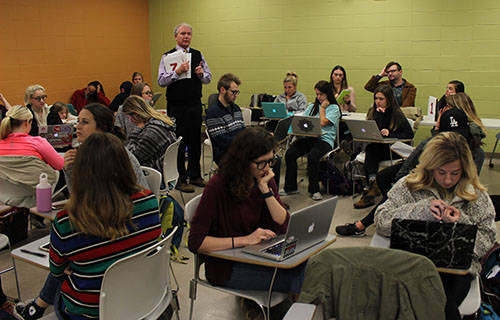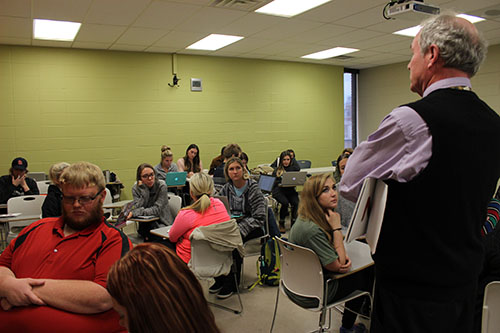Journalism Students Find All Media Had Negative Tilt During 2016 Election

Ray McCaffrey, journalism ethics professor, leads his students in examining presidential election media coverage.
Last semester, students in the Walter J. Lemke Department of Journalism at the J. William Fulbright College of Arts and Sciences analyzed media coverage, candidate Twitter accounts and advertising during the 2016 presidential election and found that on all platforms the campaign had a decidedly negative tilt.
Working from Labor Day to Election Day, journalism ethics class students divided into seven groups rated each media outlet as positive, negative or neutral for then candidates Donald J. Trump and Hillary Clinton. Students also categorized whether each candidate's tweets were positive, negative or neutral on issues of race and ethnicity.
The students found both candidates issued more negative tweets than positive ones, which also held true for campaign ads. Additionally, the New York Times and USA Today ran more negative stories about both candidates than positive stories. When the local paper, the Arkansas Democrat-Gazette, was evaluated, the students found it ran more negative stories about Trump and the opposite was true of the Clinton coverage. The students also found that both NBC and CBS ran more negative news segments about Trump as opposed to Clinton.
"It's been really interesting because I feel like this election, especially [on] social media, has been so constant," said Regan Myers, an advertising and public relations major. "It's been really cool to see how they stack up statistically between Donald Trump and Hilary Clinton."
 Ray McCaffrey and journalism students. |
 |
The class project allowed students to actively follow media coverage of the campaign from all three sequences in the journalism program, including news and editorial, broadcast and advertising and public relations.
The students found that more negative news stories translated to more overall media coverage, with Trump as the subject of nearly a third more overall front-page stories in the three newspapers. He also received about two-thirds more coverage by CBS and NBC than Clinton did. The students also found the negative advertisements and tweets drew more prominent coverage, often resulting in front-page stories.
"This project is all about independently evaluating media use during the elections, the presidential elections in particular," said Ray McCaffrey, journalism ethics professor and director of the Center for Ethics in Journalism.
McCaffrey said the journalism ethics course looks at things such as fair play, bias and common ethical principles important to journalists working in broadcast and print, but also people working in advertising and public relations.
"The idea was to figure out a way we could independently evaluate how the media was covering this campaign, and how PR professionals who are behind the candidates were waging the campaign," he said.
Broadcast students evaluated coverage on NBC and CBS because those networks provide free, online episodes of their evening newscasts. Print students evaluated the headlines and photographs on the front pages of the New York Times, USA Today and the Arkansas Democrat Gazette because those papers are available through the Razorback Readship program. Finally, advertising and public relations students evaluated each candidate's Twitter account. At the end of the semester the class evaluated the campaign advertisements together.
"For all parts of the project we're interested in looking at whether or not a tweet, a headline or an ad is delving into matters that involve race and ethnicity," McCaffrey said. "Our distinguished professor of journalism, Jesse Holland, covers those issues for the Associated Press, so we want to be attuned to that in the campaign."
The project also required students to monitor election media closely during the campaign, encouraging students to consider how politics and media work together. Evaluating media coverage also gave students an opportunity to consider claims of bias in the media by candidates.
For Nikolas Koch, a junior broadcast journalism major, the project enabled him to "learn more politics" because normally he "avoids politics," he said.
"I don't think any one network is slanted toward a candidate," Koch said. "I just think it's the way the candidates [handled] the election."
For more information, visit the center's election study page.
Contacts
Bobbie Foster, assistant director, Center for Ethics in Journalism
Department of Journalism
479-575-7047, bjf001@uark.edu